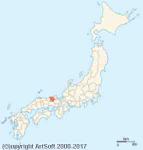Utagawa Toyoharu
Utagawa Toyoharu
Born: 1735
Death: 1814
Biography:
Utagawa Toyoharu was a Japanese artist in the ukiyo-e genre, known as the founder of the Utagawa school and for his uki-e pictures that incorporated Western-style geometrical perspective to create a sense of depth.
Born in Toyooka in Tajima Province, Toyoharu first studied art in Kyoto, then in Edo (modern Tokyo), where from 1768 he began to produce designs for ukiyo-e woodblock prints. He soon became known for his uki-e "floating pictures" of landscapes and famous sites, as well as copies of Western and Chinese perspective prints. Though his were not the first perspective prints in ukiyo-e, they were the first to appear as full-colour nishiki-e, and they demonstrate a much greater mastery of perspective techniques than the works of his predecessors. Toyoharu was the first to make the landscape a subject of ukiyo-e art, rather than just a background to figures and events. By the 1780s he had turned primarily to painting. The Utagawa school of art grew to dominate ukiyo-e in the 19th century with artists such as Utamaro, Hiroshige, and Kuniyoshi.
Utagawa Toyoharu was born c. 1735 in Toyooka in Tajima Province. He studied in Kyoto under Tsuruzawa Tangei (ja) of the Kanō school of painting. It may have been around 1763 that he moved to Edo (modern Tokyo), where he studied under Toriyama Sekien. The Toyo (春) in the art name Toyoharu (豊春) is said to have come from Sekien's personal name Toyofusa (豊房). Some sources hold he also studied under Ishikawa Toyonobu and Nishimura Shigenaga. Other art names Toyoharu went under include Ichiryūsai (一竜斎 ), Senryūsai (潜竜斎), and Shōjirō (松爾楼). Tradition holds that the name Utagawa derives from Udagawa-chō, where Toyoharu lived in the Shiba district in Edo. His common name was Tajimaya Shōjirō (但馬屋 庄次郎), and he also used the personal names Masaki (昌樹) and Shin'emon (新右衛門).
Toyoharu's work began to appear about 1768. His earliest work includes woodblock prints in a refined, delicate style of beauties and actors. Soon he began to produce uki-e "floating picture" perspective prints, a genre in which Toyoharu applied Western-style one-point perspective to create a realistic sense of depth. Most were of famous sites, including theatres, temples, and teahouses. Toyoharu's were not the first uki-e—Okumura Masanobu had made such works since the early 1740s, and claimed the genre's origin for himself. Toyoharu's were the first uki-e in the full-colour nishiki-e genre that had developed in the 1760s. Several of his prints were based on imported prints from the West or China.
From the 1780s Toyoharu appears to have dedicated himself to painting, and also produced kabuki programs and billboards. He headed the painters involved in the restoration of Nikkō Tōshō-gū in 1796. He died in 1814 and was buried in Honkyōji Temple in Ikebukuro under the Buddhist posthumous name Utagawa-in Toyoharu Nichiyō Shinji (歌川院豊春日要居士).[b]
The Canal Grande from Santa Croce to the East Canaletto, oil on canvas, 18th century
The Canal Grande from Santa Croce to the East Antonio Visentini, copperplate engraving, 1742
The Bell which Resounds for Ten Thousand Leagues in the Dutch Port of Frankai Toyoharu, woodblock print, c. 1770s
Toyoharu's works have a gentle, calm, and unpretentious touch, and display the influence of ukiyo-e masters such as Ishikawa Toyonobu and Suzuki Harunobu. Harunobu pioneered the full-colour nishiki-e print and was particularly popular and influential in the 1760s, when Toyoharu first began his career.
Toyoharu produced a number of willowy, graceful bijin-ga portraits of beauties in hashira-e pillar prints. Only about fifteen examples of his bijin-ga are known, almost all from his earliest period. One of the better-known examples of Toyoharu's work in this style is a four-sheet set depicting the Chinese ideal of the Four Arts. Toyoharu produced a small number of yakusha-e actor prints that, in contrast to the works of the leading Katsukawa school, are executed in the learned style of an Ippitsusai Bunchō.
While Toyoharu trained in Kyoto he may have been exposed to the works of Maruyama Ōkyo, whose popular megane-e were pictures in one-point perspective meant to be viewed in a special box in the manner of the French vue d'optique. Toyoharu may also have seen the Chinese vue d'optique prints made in the 1750s that inspired Ōkyo's work.
Early in his career, Toyoharu began producing the uki-e for which he is best remembered. Books on geometrical perspective translated from Dutch and Chinese sources appeared in the 1730s, and soon after, ukiyo-e prints displaying these techniques appeared first in the works of Torii Kiyotada (ja) and then of Okumura Masanobu. These early examples were inconsistent in their application of perspective techniques, and the results can be unconvincing; Toyoharu's were much more dextrous, though not strict—he manipulated it to allow the representation of figures and objects that otherwise would have been obscured. Toyoharu's works helped pioneer the landscape as an ukiyo-e subject, rather than merely a background for human figures or events, as in Masanobu's works. Toyoharu's earliest uki-e cannot be reliably dated, but are assumed to have appeared before 1772: early in that year[c] the Great Meiwa Fire (ja) in Edo destroyed the Niō-mon gate in Ueno, the subject of Toyoharu's Famous Views of Edo: Niō-mon in Ueno.[d]
More...
Wikipedia link: Click Here





